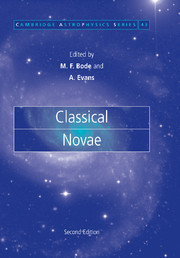Book contents
- Frontmatter
- Contents
- List of contributors
- Preface to the first edition
- Preface to the second edition
- List of symbols
- 1 Novae: an historical perspective
- 2 Properties of novae: an overview
- 3 The evolution of nova-producing binary stars
- 4 Thermonuclear processes
- 5 Nova atmospheres and winds
- 6 Observational mysteries and theoretical challenges for abundance studies
- 7 Radio emission from novae
- 8 Infrared studies of classical novae
- 9 Optical and ultraviolet evolution
- 10 X-ray emission from classical novae in outburst
- 11 Gamma-rays from classical novae
- 12 Resolved nebular remnants
- 13 Dust and molecules in nova environments
- 14 Extragalactic novae
- Object index
- Subject index
13 - Dust and molecules in nova environments
Published online by Cambridge University Press: 10 October 2009
- Frontmatter
- Contents
- List of contributors
- Preface to the first edition
- Preface to the second edition
- List of symbols
- 1 Novae: an historical perspective
- 2 Properties of novae: an overview
- 3 The evolution of nova-producing binary stars
- 4 Thermonuclear processes
- 5 Nova atmospheres and winds
- 6 Observational mysteries and theoretical challenges for abundance studies
- 7 Radio emission from novae
- 8 Infrared studies of classical novae
- 9 Optical and ultraviolet evolution
- 10 X-ray emission from classical novae in outburst
- 11 Gamma-rays from classical novae
- 12 Resolved nebular remnants
- 13 Dust and molecules in nova environments
- 14 Extragalactic novae
- Object index
- Subject index
Summary
Introduction
Dust and molecule formation in the winds of classical novae is now a well-observed, if poorly understood, phenomenon. Although the presence of dust in nova ejecta was not confirmed observationally until the 1970 infrared observations of FH Ser (Geisel, Kleinmann & Low, 1970), the subject has a much longer history. Dust formation in a classical nova was first proposed by McLaughlin (1935) to explain the precipitous deep minimum in the visual light curve of DQ Her; coincidentally, DQ Her was also the first nova to display observational evidence of a molecule (CN; Wilson & Merrill, 1935).
At first sight, the hostile environment of a classical nova is not an obvious place to find molecules and dust. This is because the chemistry that leads to the formation of first diatomic, then polyatomic, molecules, and eventually dust, requires an environment that is well shielded from the increasingly hard radiation field of the stellar remnant.
In this chapter the observational evidence for the presence of dust and molecules in the environments of classical novae is reviewed, together with the current state of our theoretical understanding of chemistry in nova winds, and of the growth and processing of the dust.
Molecules in nova ejecta
Preamble
Although CN holds the distinction of being the first molecule to be observed in the spectrum of a nova, in the optical spectrum of DQ Her in 1933 (Wilson & Merrill, 1935), molecules are in general most easily detected in the near- and mid-infrared, where common diatomic molecules (such as CO, H2, SiO) have rotational–vibrational transitions.
- Type
- Chapter
- Information
- Classical Novae , pp. 308 - 334Publisher: Cambridge University PressPrint publication year: 2008
- 19
- Cited by



